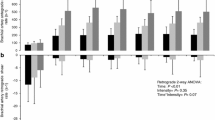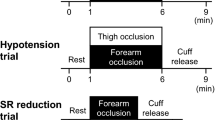Abstract
Arm elevation induces diastolic retrograde flow in the brachial artery and an incremental rise in arterial compliance in healthy subjects with no modifications in vascular resistance. In contrast, changes in resistance have been observed after handgrip exercise. Our objective was to investigate if the resistance change induced by isometric handgrip exercise is able to reverse diastolic retrograde flow induced by arm elevation in a healthy population and to explore these adaptive changes in hypertensive subjects. Arterial flow velocity Doppler measurements were obtained including: (a) a baseline measurement, (b) measurement 30 s after arm elevation, (c) measurement during handgrip maneuver with the arm elevated, (d) measurement during handgrip release with the arm elevated. Our findings showed that diastolic retrograde flow is induced by arm elevation, partially increased by arm-up handgrip and completely reversed during arm-up handgrip release both in healthy and hypertensive subjects. As compared with normal subjects, deceleration time was longer in the hypertensive subjects during baseline but not during the arm-up stage, handgrip contraction and handgrip release stages. An important increase in deceleration time values from baseline to arm-up and handgrip contraction stages was observed in normal subjects but not in the hypertensive group. We believe that the highly significant difference in reactivity to postural changes observed in deceleration time values constitutes a promising hemodynamic index to investigate. Also, our observation of complete reversal of the retrograde flow during arm-up handgrip release provides a new approach to postural and exercise-induced vasomotor responses.

Similar content being viewed by others
References
Abela GS (2004) Peripheral vascular disease: basic diagnostic and therapeutic approaches. Lippincott Publisher, Inc, New York
Anderson TJ, Elstein E, Haber H, Charbonneau F (2000) Comparative study of ACE-inhibition, angiotensin II antagonism, and calcium channel blockade on flow-mediated vasodilation in patients with coronary disease (BANFF study). J Am Coll Cardiol 35:60–66
Baccelli G, Pignoli P, Corbellini E, Pizzolati PL, Bassini M, Longo T, Zanchetti A (1985) Hemodynamic factors changing blood flow velocity waveform and profile in normal human brachial artery. Angiology 36:1–8
Barcroft H, Dornhorst AC (1949) The blood flow through the human calf during rhythmic exercise. J Physiol 109:402–411
Benjamin EJ, Larson MG, Keyes MJ, Mitchell GF, Vasan RS, Keaney JF Jr, Lehman BT, Fan S, Osypiuk E, Vita JA (2004) Clinical correlates and heritability of flow-mediated dilation in the community: the Framingham HEART Study. Circulation 109(5):613–9 (Erratum in: Circulation 2004 Jun 29; 109(25):3256)
Bochmann RP, Seibel W, Haase E, Hietschold V, Rödel H, Deussen A (2005) External compression increases forearm perfusion. J Appl Physiol 99(6):2337–2344 (Epub 2005 Aug 4)
Casey DP, Madery BD, Curry TB, Eisenach JH, Wilkins BW, Joyner MJ (2010) Nitric oxide contributes to the augmented vasodilatation during hypoxic exercise. J Physiol 588:373–385
Celermajer DS, Sorensen KE, Gooch VM, Spiegelhalter DJ, Miller OI, Sullivan ID, Lloyd JK, Deanfield JE (1992) Noninvasive detection of endothelial dysfunction in children and adults at risk of atherosclerosis. Lancet 340:1111–1115
Clifford PS, Hellsten Y (2004) Vasodilatory mechanisms in contracting skeletal muscle. J Appl Physiol 97:393–403
Corretti MC, Anderson TJ, Benjamin EJ, Celermajer D, Charbonneau F, Creager MA et al (2002) International brachial artery reactivity task Force. Guidelines for the ultrasound assessment of endothelial-dependent flow-mediated vasodilation of the brachial artery: a report of the international brachial artery reactivity task force. J Am Coll Cardiol 39(2):257–265
Credeur DP, Dobrosielski DA, Arce-Esquivel AA, Welsch MA (2009) Brachial artery retrograde flow increases with age: relationship to physical function. Eur J Appl Physiol 107(2):219–225 (Epub 2009 Jun 30)
Eklund B, Kaijser L, Knutsson E (1974) Blood flow in resting (contralateral) arm and leg during isometric contraction. J Physiol 240(1):111–124
Fronek A, Coel M, Berstein EF (1976) Quantitative ultrasonographic studies of lower extremity flow velocities in health and disease. Circulation 53(6):957–960
Gokce N, Holbrook M, Hunter LM, Palmisano J, Vigalok E, Keaney JF Jr, Vita JA (2002) Acute effects of vasoactive drug treatment on brachial artery reactivity. J Am Coll Cardiol 40(4):761–765
Gray SD, Carlsson E, Staub NC (1967) Site of increased vascular resistance during isometric muscle contraction. Am J Physiol 213:683–689
Green DJ, Bilsborough W, Naylor LH, Reed C, Wright J, O’Driscoll G, Walsh JH (2005) Comparison of forearm blood flow responses to incremental handgrip and cycle ergometer exercise. J Physiol 562:617–628
Halliwill JR, Minson CT (2010) Retrograde shear: backwards into the future? Am J Physiol Heart Circ Physiol 298:H1126–H1127
Hashimoto J, Ito S (2010) Pulse pressure amplification, arterial stiffness, and peripheral wave reflection determine pulsatile flow waveform of the femoral artery. Hypertension 56(5):926–933 (Epub 2010 Sep 27)
Hornig B, Landmesser U, Kohler C, Ahlersmann D, Spiekermann S, Christoph A, Tatge H, Drexler H (2001) Comparative effect of ACE inhibition and angiotensin II type 1 receptor antagonism on bioavailability of nitric oxide in patients with coronary artery disease: role of superoxide dismutase. Circulation 103:799–805
Humphreys PW, Lind AR (1963) The blood flow through active and inactive muscles of the forearm during sustained hand-grip contractions. J Physiol 166:120–135
Hunyor S, Nyberg G (1978) Comparison of intra-arterial and indirect blood pressures at rest and during isometric exercise in hypertensive patients before and after metoprolol. Br J Clin Pharmacol 6(2):109–114
Kirby BS, Voyles WF, Simpson CB, Carlson RE, Schrage WG, Dinenno FA (2009) Endothelium-dependent vasodilatation and exercise hyperaemia in ageing humans: impact of acute ascorbic acid administration. J Physiol 587(Pt 9):1989–2003 (Epub 2009 Mar 23)
London GM, Marchais SJ, Safar ME (1989) Arterial compliance in hypertension. J Hum Hypertens 3 Suppl 1:53–6 (Review)
Lutjemeier BJ, Miura A, Scheuermann BW, Koga S, Townsend DK, Barstow TJ (2005) Muscle contraction-blood flow interactions during upright knee extension exercise in humans. J Appl Physiol 98:1575–1583
Mc Loughlin MJ, Mc Loughlin S, Milei J (2011) Diastolic retrograde arterial flow: preliminary report. Radiologia English, Spanish (in press)
Padilla J, Young CN, Simmons GH, Deo SH, Newcomer SC, Sullivan JP, Laughlin MH, Fadel PJ (2010) Increased muscle sympathetic nerve activity acutely alters conduit artery shear rate patterns. Am J Physiol Heart Circ Physiol 298(4):H1128–H1135 (Epub 2010 Feb 12)
Padilla J, Simmons GH, Fadel PJ, Laughlin MH, Joyner MJ, Casey DP (2011) Impact of aging on conduit artery retrograde and oscillatory shear at rest and during exercise: role of nitric oxide. Hypertension 57(3):484–489 (Epub 2011 Jan 24)
Panza JA, Quyyumi AA, Brush JE et al (1990) Abnormal endothelium-dependent vascular relaxation in patients with essential hypertension. N Engl J Med 323:22–27
Perticone F, Ceravolo R, Pujia A, Ventura G, Iacopino S, Scozzafava A, Ferraro A, Chello M, Mastroroberto P, Verdecchia P, Schillaci G (2001) Prognostic significance of endothelial dysfunction in hypertensive patients. Circulation 104(2):191–196
Plavnik FL, Ajzen SA, Christofalo DM, Barbosa CS, Kohlmann O Jr (2007) Endothelial function in normotensive and high-normal hypertensive subjects. J Hum Hypertens 21(6):467–472 (Epub 2007 Feb 8)
Pyke KE, Poitras V, Tschakovsky ME (2008) Brachial artery flow-mediated dilation during handgrip exercise: evidence for endothelial transduction of the mean shear stimulus. Am J Physiol Heart Circ Physiol 294(6):H2669–H2679 (Epub 2008 Apr 11)
Sadamoto T, Bonde-Petersen F, Suzuki Y (1983) Skeletal muscle tension, flow, pressure, and EMG during sustained isometric contractions in humans. Eur J Appl Physiol 51:395–408
Safar ME, Peronneau PA, Levenson JA, Toto-Moukouo JA, Simon AC (1981) Pulsed Doppler: diameter, blood flow velocity and volumic flow of the brachial artery in sustained essential hypertension. Circulation 63(2):393–400
Shoemaker JK, Halliwill JR, Hughson RL, Joyner MJ (1997) Contributions of acetylcholine and nitric oxide to forearm blood flow at exercise onset and recovery. Am J Physiol 273(5 Pt 2):H2388–H2395
Thijssen DH, Dawson EA, Tinken TM, Cable NT, Green DJ (2009) Retrograde flow and shear rate acutely impair endothelial function in humans. Hypertension 53(6):986–992 (Epub 2009 Apr 20)
Thijssen DH, Black MA, Pyke KE, Padilla J, Atkinson G, Harris RA, Parker B, Widlansky ME, Tschakovsky ME, Green DJ (2011) Assessment of flow-mediated dilation in humans: a methodological and physiological guideline. Am J Physiol Heart Circ Physiol 300(1):H2–H12 (Epub 2010 Oct 15. Review)
Tinken TM, Thijssen DH, Hopkins N, Black MA, Dawson EA, Minson CT, Newcomer SC, Laughlin MH, Cable NT, Green DJ (2009) Impact of shear rate modulation on vascular function in humans. Hypertension 54(2):278–285 (Epub 2009 Jun 22)
Urbina EM, Williams RV, Alpert BS, Collins RT, Daniels SR, Hayman L et al (2009) Noninvasive assessment of subclinical atherosclerosis in children and adolescents. Recommendations for standard assessment for clinical research: a scientific statement from the American Heart Association. Hypertension 54(5):919–950 (Epub 2009 Sep 3)
Wray DW, Witman MA, Ives SJ, McDaniel J, Fjeldstad AS, Trinity JD, Conklin JD, Supiano MA, Richardson RS (2011) Progressive handgrip exercise: evidence of nitric oxide-dependent vasodilation and blood flow regulation in humans. Am J Physiol Heart Circ Physiol 300(3):H1101–H1107 (Epub 2011 Jan 7)
Young CN, Deo SH, Padilla J, Laughlin MH, Fadel PJ (2010) Pro-atherogenic shear rate patterns in the femoral artery of healthy older adults. Atherosclerosis 211:390–392
Zamir M, Goswami R, Salzer D, Shoemaker JK (2007) Role of vascular bed compliance in vasomotor control in human skeletal muscle. Exp Physiol 92(5):841–848 (Epub 2007 Jun 1)
Acknowledgments
We acknowledge Liliana Brocca for her help during the investigation.
Conflict of interest
The authors declare no conflict of interest.
Author information
Authors and Affiliations
Corresponding author
Additional information
Communicated by Dag Linnarsson.
Rights and permissions
About this article
Cite this article
Mc Loughlin, S., Mc Loughlin, M.J., Azzato, F. et al. Retrograde flow components in the brachial artery. A new hemodynamic index. Eur J Appl Physiol 112, 3577–3583 (2012). https://doi.org/10.1007/s00421-012-2347-3
Received:
Accepted:
Published:
Issue Date:
DOI: https://doi.org/10.1007/s00421-012-2347-3




